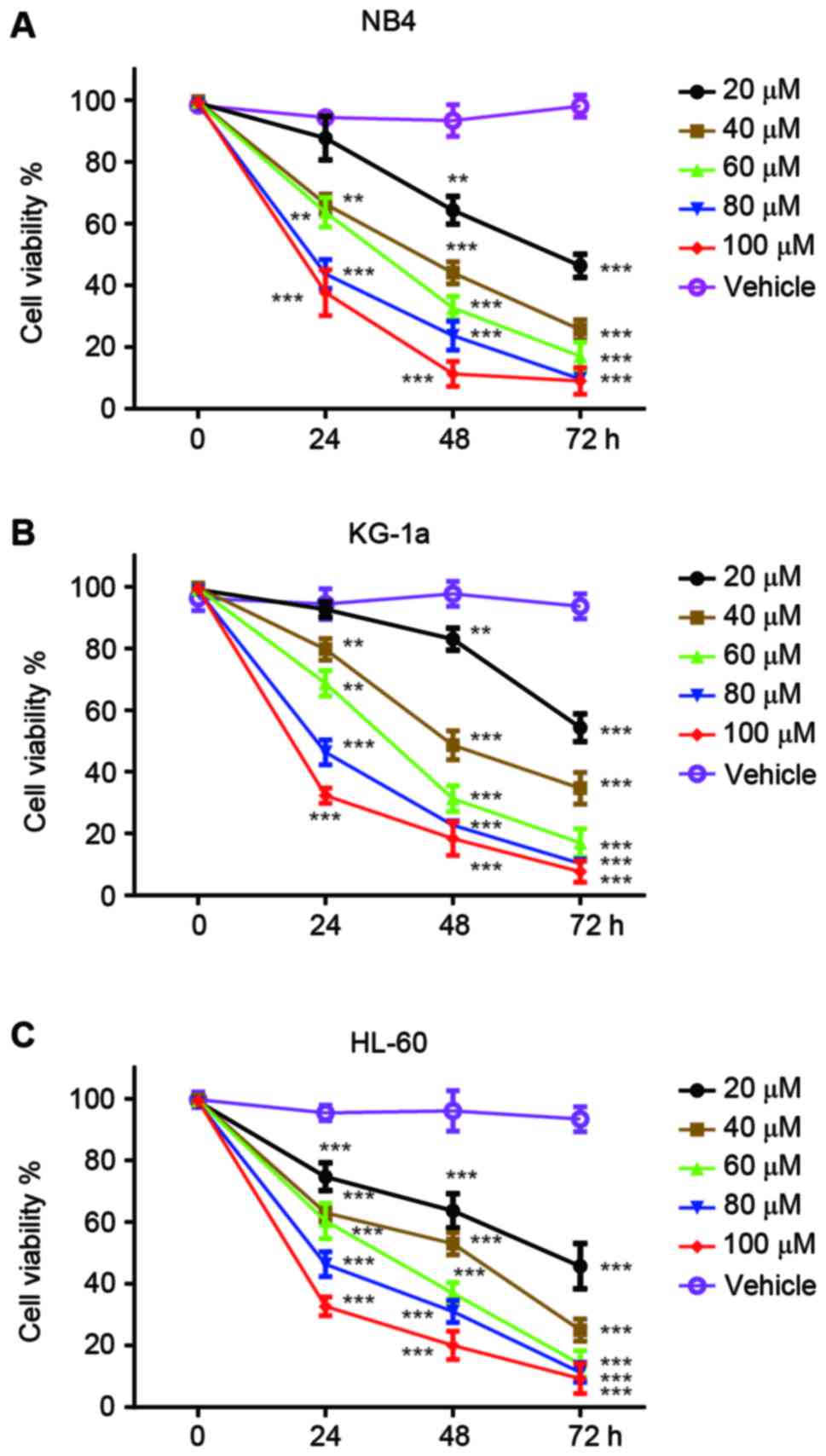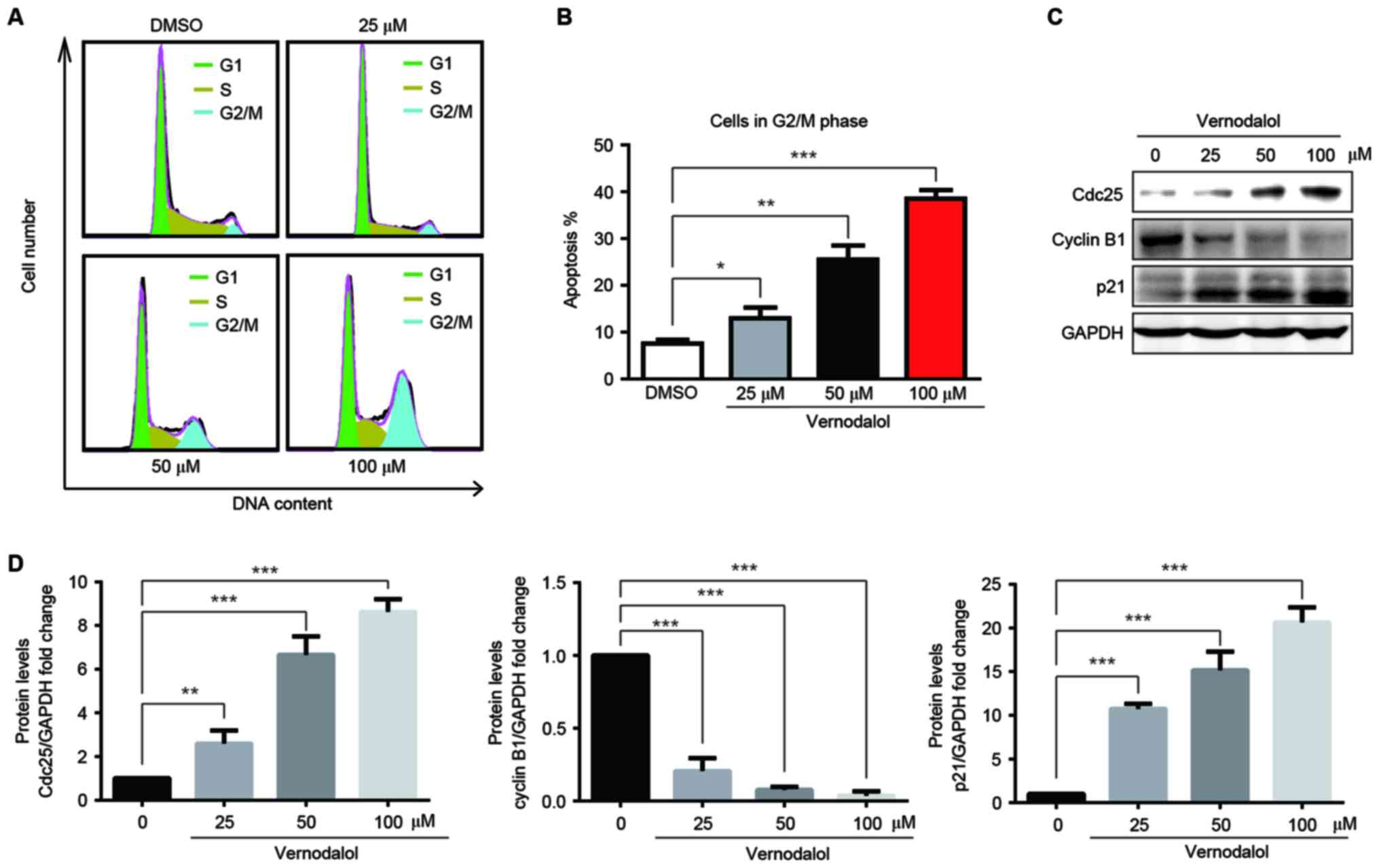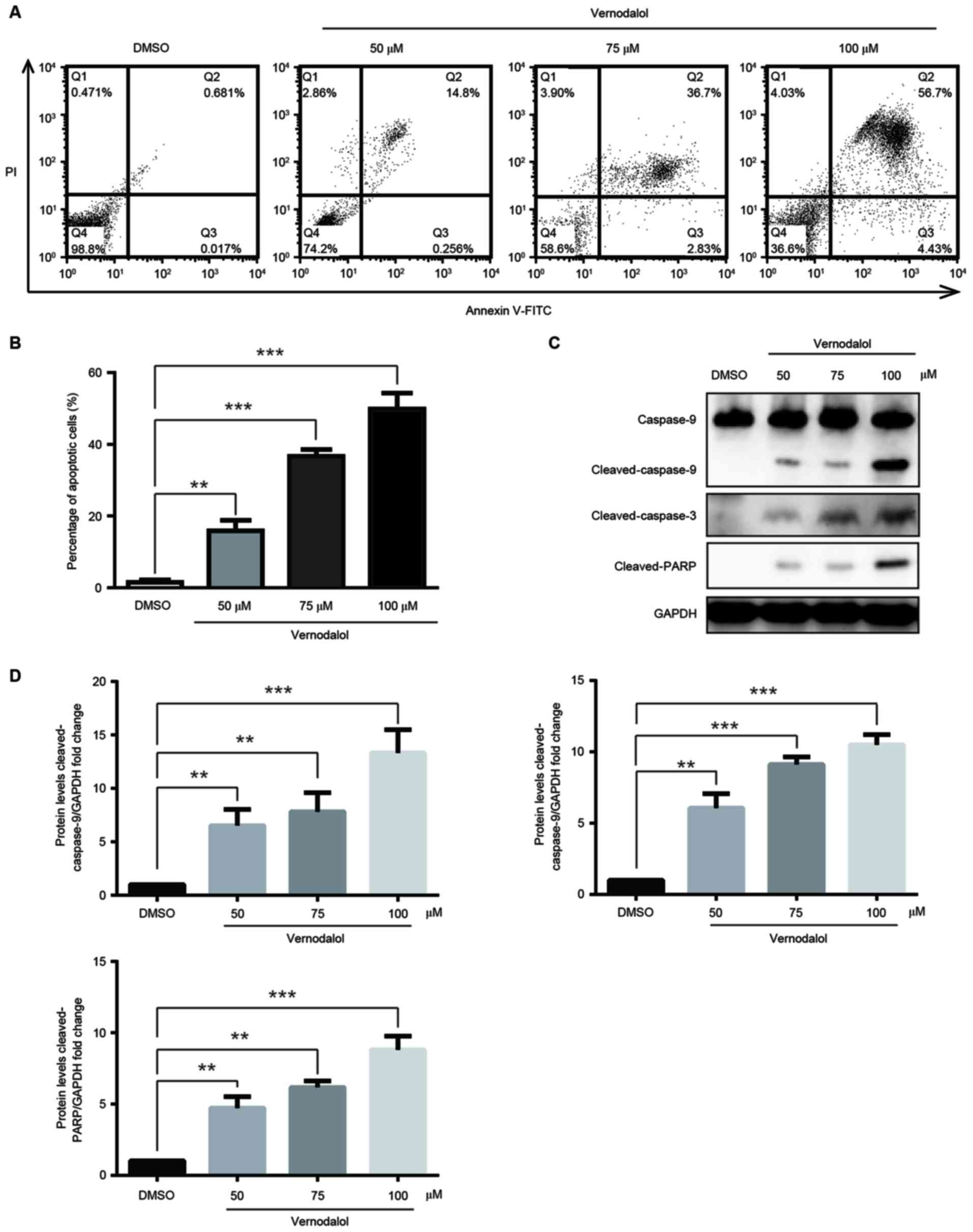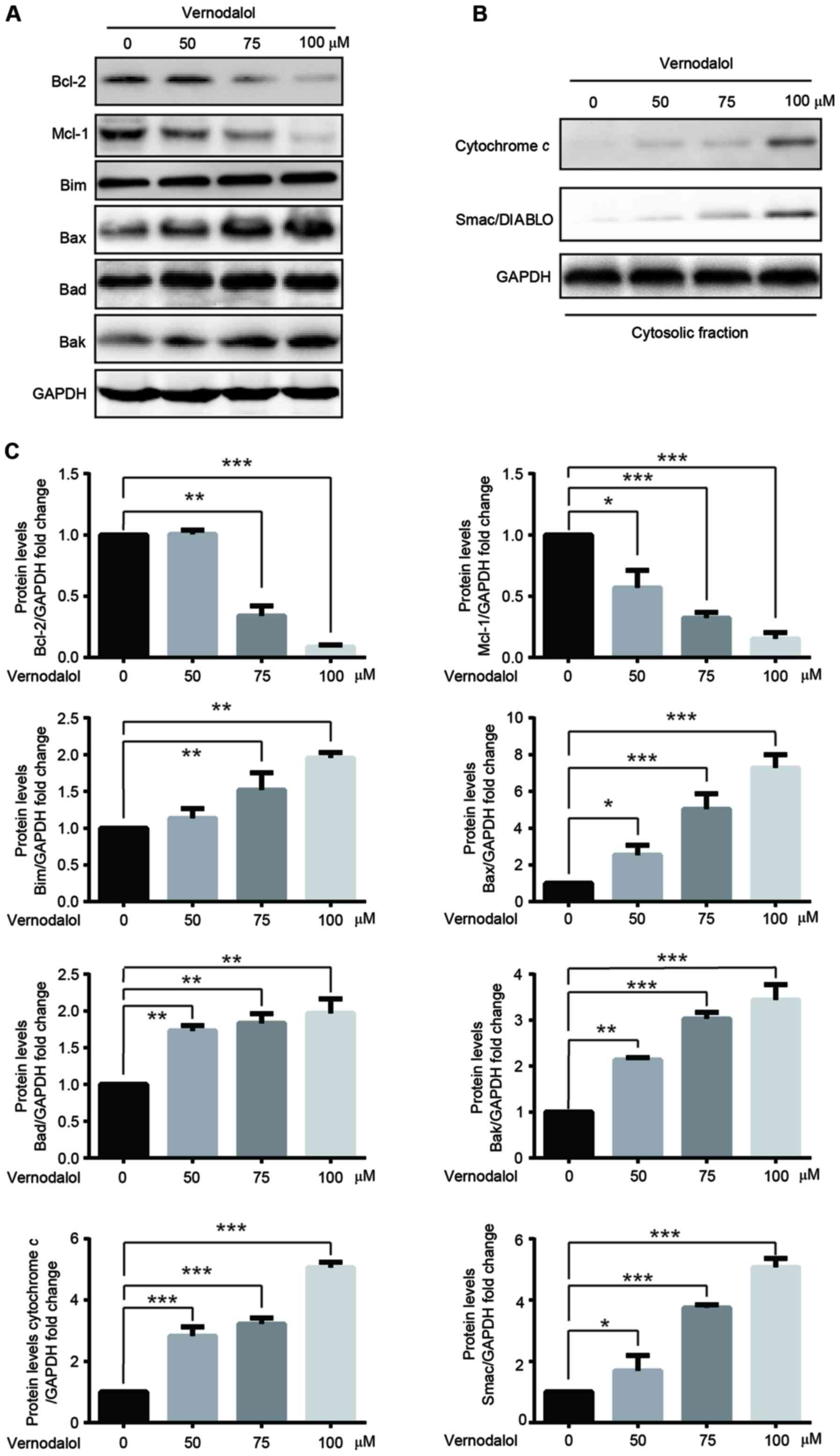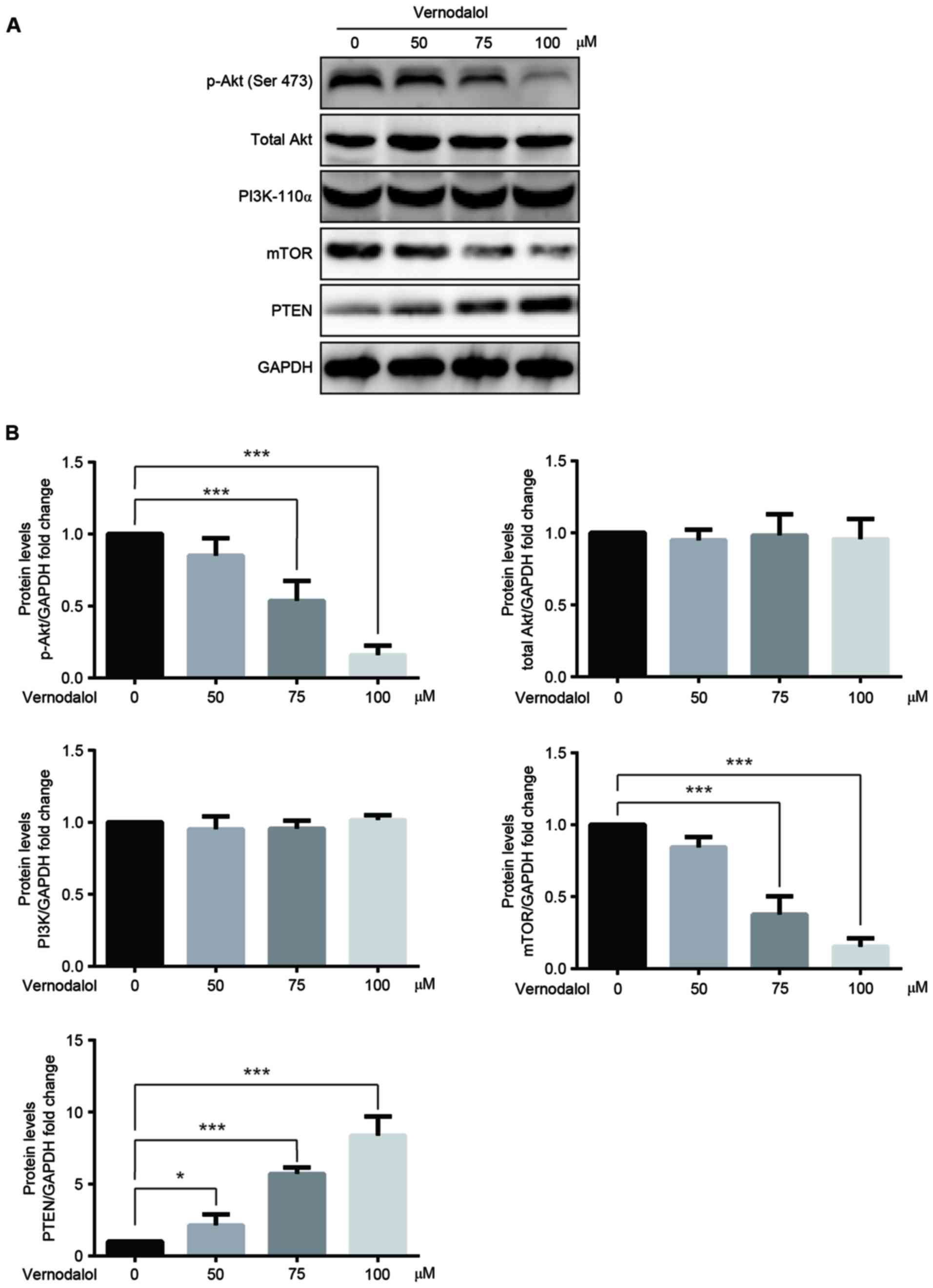Vernodalol mediates antitumor effects in acute promyelocytic leukemia cells
- Authors:
- Published online on: December 7, 2017 https://doi.org/10.3892/ol.2017.7544
- Pages: 2227-2235
-
Copyright: © Wu et al. This is an open access article distributed under the terms of Creative Commons Attribution License.
Abstract
Introduction
Acute promyelocytic leukemia (APL) is the M3 subtype of acute myeloid leukemia (AML) that results from an arrest of the terminal differentiation of promyelocytes into granulocytes (1,2). APL accounts for 5–15% of all cases of AML and is frequently associated with the expression of the oncogenic promyelocytic leukemia-retinoic acid receptor α fusion gene (3,4). Clinically, APL is now considered a fatal disease with a high rate of early mortality, often due to hemorrhage from disseminated intravascular coagulation (DIC) or hyperfibrinolysis (5). Chemotherapy with anthracyclines, including daunorubicin, idarubicin and cytarabine arabinoside, which are the frontline treatments of APL, resulted in complete remission in 75–80% of patients (6,7). However, this standard treatment regimen was associated with a high early mortality rate due to the exacerbation of pre-existing DIC (5,7,8). Despite high sensitivity to anthracycline, only 35–45% of patients with APL are cured by standard chemotherapy alone (9). Therefore, it is urgently required to develop novel therapeutic agents for patients with APL to overcome the high early mortality rate.
Centratherum anthelminticum
commonly termed kalajiri, somraj, black cumin or bitter cumin, is a robust leafy plant belonging to the Asteraceae family of flowering plants (10). The plant has additional scientific synonyms, including Vernonia anthelmintica and Conyza anthelmintica. It is widely used as an herbal medicine against cough, fever and diarrhea in a number of regions, including India, the Himalaya mountains, Khasi Hills, Sri Lanka and Afghanistan (11). The extracts from the seeds of C. anthelminticum have been demonstrated to possess various pharmacological properties, including analgesic, antipyretic, anti-inflammatory, antiviral and anti-filarial effects (12–15). A previous study reported that the chloroform fraction, but not the hexane or methanol fractions, from C. anthelminticum seeds exhibited antioxidant properties of inhibiting tumor necrosis factor-α-induced human cancer cell growth by interrupting the activation of nuclear factor-κB activation (16). Vernodalin is an active compound isolated through bioassay-guided fractionation, which can induce apoptosis in human breast cancer cells via the caspase pathway (10). In addition, vernodalin can induce cell cycle arrest and apoptosis in breast cancer cells through forkhead box O3a (11). Vernodalol is similar to vernodalin, and both can be extracted from C. anthelminticum (10). However, the effects of vernodalol on carcinoma cells have not been studied.
The present study investigated the antitumor effects of vernodalol on APL cells. The effect of vernodalol on the APL cell cycle and apoptosis was assessed, and the associated molecular mechanisms were investigated. Results of the present study indicated that vernodalol may be utilized as a potent medicine for the treatment of APL.
Materials and methods
Reagents and cell culture
Vernodalol was obtained from Sigma-Aldrich (Merck KGaA, Darmstadt, Germany). Antibodies specific for caspase-9 (cat. no. CST 9502), caspase-3 (cat. no. CST 9662), cleaved-poly (ADP ribose) polymerase (PARP; cat. no. CST 9542), B-cell lymphoma-2 (Bcl-2; cat. no. CST 2872), Bcl-2-associated X protein (Bax; cat. no. CST 2774), Bcl-2-associated death promoter (Bad; cat. no. CST 9292) and Bcl-2 homologous antagonist killer (Bak; cat. no. CST 3814) were obtained from Cell Signaling Technology, Inc. (Danvers, MA, USA). Antibodies specific for phosphatase and tensin homolog (PTEN; sc-7974), myeloid cell leukemia-1 (Mcl-1; sc-12756), Bcl-2-like protein 11 (Bim; sc-130511), cytochrome c (sc-13561) and second mitochondria-derived activator of caspase/direct IAP-binding protein with low pI (Smac/DIABLO; sc-22766) were purchased from Santa Cruz Biotechnology, Inc. (Dallas, TX, USA). Antibodies specific for phosphorylated (p)-protein kinase B (Akt; ab38449), Akt (ab8805), phosphoinositide 3-kinase (PI3K; ab86714) and mechanistic target of rapamycin (mTOR; ab2732) were purchased from Abcam (Cambridge, MA, USA). Anti-GAPDH antibody was obtained from Sigma-Aldrich (Merck KGaA; G9545). The Annexin V/propidium iodide (PI) binding kit was purchased from BD Biosciences (San Jose, CA, USA). All other chemicals of analytical grade were obtained from Sigma-Aldrich (Merck KGaA). Human APL cell lines, KG-1a, NB-4 and HL-60, were obtained from Shanghai Centre of Cell Resource, Chinese Academy of Sciences (Shanghai, China). All cell lines were maintained at 37°C in RPMI-1640 (Gibco; Thermo Fisher Scientific, Inc.) supplemented with 10% heat-inactivated fetal bovine serum (Sigma-Aldrich; Merck KGaA) and 1% penicillin/streptomycin in a humidified atmosphere containing 5% CO2. All cells were passaged every 3 days.
Cell viability assay
The effects of vernodalol on viability of human APL cells were analyzed by MTT assay (Sigma-Aldrich; Merck KGaA). Briefly, 5×103 cells per well were plated on 96-well plates and treated with vernodalol at various concentrations (20, 40, 60, 80 and 100 µM) for the indicated times (24, 48 or 72 h). The RPMI-1640 with the compounds or 0.5% dimethyl sulfoxide (DMSO; as the control treatment) was then replaced with 180 µl of fresh media with 20 µl of MTT solution (MTT dissolved in PBS at 5 mg/ml) per well and incubated at 37°C for 4 h. The MTT-containing medium was discarded, and DMSO (150 µl/well) was added to dissolve the newly formed formazan crystals. The absorbance of each well was determined by a microplate reader (Synergy H4; BioTek China, Beijing, China) at a wavelength of 590 nm.
Cell cycle analysis
The cells were cultured on 6-well plates at 37°C to reach 70–80% confluence with RPMI-1640 and then treated with vernodalol at various concentrations (25, 50 or 100 µM) for the indicated time. The vernodalol-treated and control cells were harvested by centrifugation for 5 min at 377 × g and room temperature and fixed in 4 ml ice-cold 75% ethanol at 4°C overnight. The cells were stained with 200 µl PI (50 µg/ml; Sigma-Aldrich; Merck KGaA) at 37°C for 10 min and incubated with 20 µl RNase (1 mg/ml; Sigma-Aldrich; Merck KGaA) for removal of RNA in a 37°C water bath for 15–20 min. The cells were then analyzed by flow cytometry (FACScan; BD Biosciences). The results are presented as mean values from three independent experiments.
Cell apoptosis analysis
The cells were cultured (5×105) in each well of 6-well plates to 70–80% confluence with RPMI-1640 and then treated with vernodalol at various concentrations (0, 50, 75 or 100 µM) for the indicated time (24 h). The vernodalol-treated and control cells (treated with DMSO only) were harvested by centrifugation for 5 min at 377 × g and room temperature and washed twice with cold 1X PBS. The cells were then stained with 5 µl Annexin V and PI (BD Biosciences) for 15 min in dark conditions at room temperature according to the manufacturer's protocol and then subjected to analysis by flow cytometry (FACS Calibur; BD Biosciences). Data were analyzed using Flowjo software version 10.0 (Tree Star, Inc., Ashland, OR, USA). Early apoptosis was evaluated based on the percentage of cells with Annexin V+/PI− staining, and late apoptosis was evaluated based on the percentage of cells with Annexin V+/PI+ staining.
Preparation of subcellular fractions
To separate the cytosolic and mitochondrial fractions, the cells were washed with ice-cold PBS. The cells were then lysed using Cell Lysis and Mitochondria Intact buffer (250 mM sucrose, 80 mM KCl and 50 µg/ml digitonin in PBS) on ice for 5 min. The cell suspension was centrifuged at 377 × g for 5 min at 4°C. The supernatant was removed and stored at −20°C as the cytosolic fraction.
Western blot analysis
The cells were treated with vernodalol at different concentrations (0, 50, 75 or 100 µM) for the indicated time (24 h). The cells were extracted and lysed with CHAPS lysis buffer (Beyotime Institute of Biotechnology, Beijing, China) for 30 min on ice and then centrifuged at 12,000 × g for 15 min at 4°C. The total protein concentration was determined with bicinchoninic acid protein assay kit (Beyotime Institute of Biotechnology). Equal amounts (30 µg per lane) of protein samples were subjected to 8–12% SDS-PAGE electrophoresis and transferred to polyvinylidene fluoride membranes (EMD Millipore, Billerica, MA, USA). Each membrane was blocked with 10% non-fat milk at room temperature for 2 h and incubated with primary antibodies (caspase-9, caspase-3, PARP, Bcl-2, Bax, Bcl-2, Bad, Bak, PTEN, Bim, cytochrome c, Smac/DIABLO, Akt, PI3K, mTOR and GAPDH) at 4°C overnight, followed by incubation with goat anti-mouse (cat. no. SZ200) or anti-rabbit (cat. no. SZ2004) secondary antibodies (1:1,000 dilution; Santa Cruz Biotechnology, Inc.) conjugated to horseradish peroxidase at room temperature for 2 h. The relative protein expression levels were quantified using Image-Pro Plus software version 6.0 (Media Cybernetics, Inc., Rockville, MD, USA) and normalized to GAPDH.
Statistical analysis
Statistical analysis was performed using GraphPad Prism version 5.01 (GraphPad Software, Inc., La Jolla, CA, USA) and expressed as the mean ± standard deviation. The values of half-maximal inhibitory concentration (IC50) were fitted using a nonlinear regression model with a sigmoidal dose response. The values were evaluated by one-way analysis of variance followed by Tukey's multiple comparison, which was utilized to determine the significance of controls and treated groups. P<0.05 was considered to indicate a statistically significant difference.
Results
Vernodalol inhibits the growth of human acute promyelocytic leukemia cells
The antitumor effects of vernodalol were initially tested using three human APL cell lines, NB4, KG-1a and HL-60. Cells were treated with different concentrations of vernodalol or vehicle (DMSO) for 24, 48 and 72 h, and the cell viability was determined by MTT assay. As shown in Fig. 1, the treatment of three APL cell lines with vernodalol resulted in a dose- and time-dependent attenuation of cell viability. IC50 values were calculated and are listed in Table I. The results showed that vernodalol inhibits the growth of APL cells in a dose- and time-dependent manner (P<0.01). Among these three APL cell lines, HL-60 was more sensitive to vernodalol compared with NB4 and KG-1a cell lines. Therefore, HL-60 was selected for subsequent experiments.
Vernodalol induces G2/M growth arrest
To examine whether vernodalol inhibited proliferation through the induction of cell cycle arrest, the effect of vernodalol on the cell cycle was assessed. HL-60 cells were treated with different concentrations of vernodalol for 24 h, and the DNA-based cell cycle was analyzed by flow cytometry following PI staining. Vernodalol caused a marked accumulation of cells in the G2/M phase in a dose-dependent manner (Fig. 2A and B). Western blot analysis was performed to examine the effect of vernodalol on possible cell cycle-associated targets, including p21, cyclin B1 and Cdc25. As shown in Fig. 2C and D, vernodalol induced the upregulation of p21 and Cdc25 and the downregulation of cyclin B1 in a dose-dependent manner. These data indicated that vernodalol may induce G2/M cell cycle arrest via cell cycle regulatory molecules in APL cells.
Vernodalol induces apoptosis through the mitochondrial apoptosis pathway
Next, it was examined whether vernodalol had an effect on cell apoptosis. HL-60 cells were stained with Annexin V/PI subsequent to being treated with different concentrations of vernodalol for 24 h and subjected to flow cytometric analysis. As shown in Fig. 3A and B, the proportion of cells in early apoptosis (Annexin V+/PI−; right lower quadrant), as well as late apoptosis (Annexin V+/PI+; right upper quadrant), was increased with the different concentrations of vernodalol in a dose-dependent manner. These data indicated that vernodalol is able to induce cell apoptosis in human APL cells.
To elucidate the mechanism by which vernodalol induced cell apoptosis, apoptosis-associated proteins were examined following treatment with vernodalol. The results indicated that vernodalol caused cleavage of caspase-9 and −3 in HL-60 cells (Fig. 3C and D). In addition, cleaved PARP was also detected, which is a marker of cells undergoing apoptosis (Fig. 3C and D). This suggested that the caspase cascade and PARP inactivation are involved in vernodalol-mediated apoptosis. As demonstrated in Fig. 4, vernodalol downregulated the expression of Bcl-2 and Mcl-1 but upregulated Bim, Bax and Bad expression in a dose-dependent manner. In addition, it was investigated whether the mitochondrial apoptosis pathway was involved in vernodalol-induced apoptosis. The release of cytochrome c and Smac into the cytosol was measured following cell treatment with vernodalol. Vernodalol caused a significant increase in the expression of cytochrome c and Smac/DIABLO in the cytosol (Fig. 4B and C). These results indicated that vernodalol induces cell apoptosis through the mitochondrial apoptosis pathway in APL cells.
Vernodalol inhibits the PI3K/Akt signaling pathway
It has been reported that the inhibition of the PI3K/Akt/mTOR signaling pathway has a vital role in the inhibition of tumors (17). Therefore, western blot analysis was performed to investigate whether the PI3K/Akt/mTOR signaling pathway was involved in the vernodalol-mediated anticancer effects. The results demonstrated that the phosphorylation of Akt at Ser473 as well as the expression of mTOR, a well-known downstream target of Akt, were downregulated in cells treated with vernodalol in a dose-dependent manner (Fig. 5). Furthermore, there were little changes in the levels of PI3K-p110α and total Akt. Additionally, PTEN, a key negative regulator of the PI3K/Akt pathway, was upregulated in the treated cells (Fig. 5) compared with the untreated cells. These results provide compelling preliminary data that vernodalol may exert its antitumor function through inhibition of the PI3K/Akt/mTOR signal pathway.
Discussion
APL is a distinct subtype of acute leukemia (9). Patients with APL exhibit a tendency to bleed severely and prognosis is poor with a fatal course in only weeks (5). Although the clinical outcomes of refractory, relapsed and newly diagnosed patients with APL have been greatly improved, the mortality rate remains high (18). The present study demonstrated that vernodalol isolated from C. anthelminticum exerted antitumor effects in human APL cells. Vernodalol suppressed growth of human APL cells by inducing apoptosis through the mitochondrial pathway and causing cell cycle arrest in the G2/M phase. In addition, the results suggested that the strong cytokinetic effects of vernodalol were in part mediated via inhibition of the PI3K/Akt signaling pathway.
Vernodalol is a sesquiterpene lactone isolated from the seeds of C. anthelmintica (19). To date, a limited number of studies, which investigate the anti-cancer effects of vernodalol in human breast cancer cells and skin cancer models have been performed (10,20). These studies demonstrated the cytotoxic activity of vernodalol on melanoma and ovarian cancer cell lines, and human nasopharyngeal carcinoma (21,22). However, the effect and the precise mechanism of vernodalol on human APL cells, remains unclear. To the best of our knowledge, this is the first study investigating the function and mechanism of vernodalol in human APL cells.
Cell cycle dysregulation contributes to tumor initiation and progression. Therefore, cell cycle arrest has become the major focus of anticancer treatments (23). The majority of chemotherapeutic agents cause cell cycle arrest either at the G0/G1 or G2/M stage (24,25). In the present study, downregulation of cyclin B1 expression and upregulation of p21 and Cdc25, was observed following vernodalol treatment. p21, which belongs to the Cip/Kip family of cyclin-dependent kinase (CDK) inhibitors, binds to and inhibits the kinase activity of CDK2 and CDK1, leading to growth arrest at specific stages of the cell cycle (26). Cdc25C triggers G2 progression to mitosis by dephosphorylation of the cyclin B1/Cdk1 complex (26). Cyclin B1 is also a key cell cycle regulator of the G2/M phase transition, and the prototypical cyclin B1 reaches maximum levels in G2 when it enters the nucleus to form a complex with Cdk1 in a phosphorylation-dependent manner (27). It has been reported that the overexpression of cyclin B1 causes uncontrolled cell growth and may even promote the malignant transformation required for the initiation of mitosis (28). Taken together, the present data suggest a novel cell cycle regulating property of vernodalol via G2-phase arrest in human APL cells.
Apoptosis, a complex program of cell death, is regulated by numerous molecular signaling pathways (29). A study has shown that the mitochondrial pathway performs a key role in the apoptotic process (10). In this pathway, there is an increase in the release of apoptogenic factors (cytochrome c and Smac/DIABLO) from the outer mitochondrial membrane space into the cytosol due to changes in the mitochondrial membrane potential (Dym). The Bcl-2 family is a major regulator of programmed cell death (30). A previous study reported that Bcl-2 can block cell death in mitochondria by inhibiting the apoptosis-associated release of cytochrome c from the mitochondria (30). Results of the present study indicated a decrease in the levels of anti-apoptotic proteins Bcl-2 and Mcl-1 and an increase in pro-apoptotic proteins Bim, Bax and Bad following treatment with vernodalol (Fig. 4A). Furthermore, the levels of cytochrome c and Smac/DIABLO were increased in the cytosol following treatment with vernodalol. Therefore, the present findings indicated that treatment with vernodalol induces apoptosis in a manner that is dependent on activation of the mitochondrial apoptosis pathway.
The PI3K/Akt signaling pathway is a cell survival pathway that is important for normal cell growth and proliferation (31). Numerous studies have demonstrated that the PI3K/Akt signaling pathway is involved in various cellular functions, including protein synthesis, cell cycle progression, cell survival, apoptosis and angiogenesis (31,32). The amplification of PI3K/Akt signal transduction is the main cause of cellular growth, and the aberrant activation of PI3K/Akt due to genetic variation in key genes has been observed in several types of cancer, including leukemia and esophageal cancer (33,34). It has been reported that the PI3K/Akt signaling axis is constitutively activated in APL, and the addition of PI3K and mTOR inhibitors to induction treatment regimens may provide therapeutic benefits for APL (33,35). Akt is one of the major downstream effectors of PI3K (36). Upon PI3K activation, Akt is translocated to the inner membrane via its pleckstrin homology domain where it is phosphorylated by 3-phosphoinositide-dependent kinase-1 on its activation loop (37). This Akt modification is sufficient to activate the mTOR complex 1, which was originally identified as a crucial component of insulin receptor intracellular signaling (38). PTEN, a tumor suppressor phosphatase and tensin homolog, may antagonize PI3K/Akt signaling (39). PTEN was identified as a frequently mutated gene in numerous types of tumors, particularly endometrium, skin, brain and prostate (40). A study has also revealed that the downregulation of PI3K, Akt and mTOR and increased PTEN gene expression induces apoptosis and inhibits cell cycle progression in the HL-60 cell line (33). Therefore, the abrogation of PI3K or Akt function may be crucial for APL therapy. In the present study, western blot analysis demonstrated that vernodalol attenuated the phosphorylation of Akt at Ser473 and the expression of the downstream target mTOR and increased the expression of tumor suppressor PTEN (Fig. 5A) in a dose-dependent manner in human APL cells. These results suggest that vernodalol may induce apoptosis and inhibit cell cycle G2/M arrest by suppressing the PI3K/Akt signaling pathway. However, further investigation is required to validate this hypothesis.
In conclusion, to the best of our knowledge, the present study reported for the first time that vernodalol, an active compound isolated from C. anthelminticum, has a potential therapeutic function in human APL cells. Vernodalol induces cell apoptosis and G2/M growth arrest. In addition, the present findings also highlighted the ‘therapeutic value of the repression of the PI3K/Akt pathway by vernodalol in human APL cells. Therefore, vernodalol may be a potential candidate used for the treatment of APL, subsequent to further investigation.
Acknowledgements
The present study was supported by the National Natural Science Foundation of China (grant no. 30900533), the Science Foundation of Traditional Medicine Zhejiang Province (grant no. 2013ZB080) and the Science Foundation of National Health and Family Planning Commission (grant no. 2014BAI09B12).
References
|
Bennett JM, Catovsky D, Daniel MT, Flandrin G, Galton DA, Gralnick HR and Sultan C: Proposals for the classification of the acute leukaemias. French-American-British (FAB) co-operative group. Br J Haematol. 33:451–458. 1976. View Article : Google Scholar : PubMed/NCBI | |
|
Vardiman JW, Thiele J, Arber DA, Brunning RD, Borowitz MJ, Porwit A, Harris NL, Le Beau MM, Hellström-Lindberg E, Tefferi A and Bloomfield CD: The 2008 revision of the World Health Organization (WHO) classification of myeloid neoplasms and acute leukemia: Rationale and important changes. Blood. 114:937–951. 2009. View Article : Google Scholar : PubMed/NCBI | |
|
Castaigne S, Chomienne C, Daniel MT, Ballerini P, Berger R, Fenaux P and Degos L: All-trans retinoic acid as a differentiation therapy for acute promyelocytic leukemia. I. Clinical results. Blood. 76:1704–1709. 1990.PubMed/NCBI | |
|
Chen Z, Tong JH, Dong S, Zhu J, Wang ZY and Chen SJ: Retinoic acid regulatory pathways, chromosomal translocations and acute promyelocytic leukemia. Genes Chromosomes Cancer. 15:147–156. 1996. View Article : Google Scholar : PubMed/NCBI | |
|
Jones ME and Saleem A: Acute promyelocytic leukemia. A review of literature. Am J Med. 65:673–677. 1978. View Article : Google Scholar : PubMed/NCBI | |
|
Cunningham I, Gee TS, Reich LM, Kempin SJ, Naval AN and Clarkson BD: Acute promyelocytic leukemia: Treatment results during a decade at Memorial Hospital. Blood. 73:1116–1122. 1989.PubMed/NCBI | |
|
Sanz MA, Jarque I, Martin G, Lorenzo I, Martínez J, Rafecas J, Pastor E, Sayas MJ, Sanz G and Gomis F: Acute promyelocytic leukemia. Therapy results and prognostic factors. Cancer. 61:7–13. 1988. View Article : Google Scholar : PubMed/NCBI | |
|
Fenaux P, Wang ZZ and Degos L: Treatment of acute promyelocytic leukemia by retinoids. Curr Top Microbiol Immunol. 313:101–128. 2007.PubMed/NCBI | |
|
Kamimura T, Miyamoto T, Harada M and Akashi K: Advances in therapies for acute promyelocytic leukemia. Cancer Sci. 102:1929–1937. 2011. View Article : Google Scholar : PubMed/NCBI | |
|
Looi CY, Arya A, Cheah FK, Muharram B, Leong KH, Mohamad K, Wong WF, Rai N and Mustafa MR: Induction of apoptosis in human breast cancer cells via caspase pathway byvernodalol isolated from Centratherum anthelminticum (L.) seeds. PLoS One. 8:e566432013. View Article : Google Scholar : PubMed/NCBI | |
|
Sadagopan SK Ananda, Mohebali N, Looi CY, Hasanpourghadi M, Pandurangan AK, Arya A, Karimian H and Mustafa MR: Forkhead box transcription factor (FOXO3a) mediates the cytotoxic effect ofvernodalol in vitro and inhibits the breast tumor growth in vivo. J Exp Clin Cancer Res. 34:1472015. View Article : Google Scholar : PubMed/NCBI | |
|
Ashok P, Koti BC, Thippeswamy AH, Tikare VP, Dabadi P and Viswanathaswamy AH: Evaluation of antiinflammatory activity of Centratherum anthelminticum (L) Kuntze seed. Indian J Pharm Sci. 72:697–703. 2010. View Article : Google Scholar : PubMed/NCBI | |
|
Purnima A, Koti BC, Tikare VP, Viswanathaswamy AH, Thippeswamy AH and Dabadi P: Evaluation of analgesic and antipyretic activities of Centratherum anthelminticum (L) Kuntze seed. Indian J Pharm Sci. 71:461–464. 2009. View Article : Google Scholar : PubMed/NCBI | |
|
Sharma S and Mehta BK: In vitro antimicrobial efficacy of Centratherum anthelminticum seeds extracts. J Hyg Epidemiol Microbiol Immunol. 35:157–161. 1991.PubMed/NCBI | |
|
Singhal KC, Sharma S and Mehta BK: Antifilarial activity of Centratherum anthelminticum seed extracts on Setaria cervi. Indian J Exp Biol. 30:546–548. 1992.PubMed/NCBI | |
|
Arya A, Achoui M, Cheah SC, Abdelwahab SI, Narrima P, Mohan S, Mustafa MR and Mohd MA: Chloroform fraction of Centratherum anthelminticum (L.) seed inhibits tumor necrosis factor alpha and exhibits pleotropic bioactivities: Inhibitory role in human tumor cells. Evid Based Complement Alternat Med. 2012:6272562012. View Article : Google Scholar : PubMed/NCBI | |
|
Manning BD and Cantley LC: AKT/PKB signaling: Navigating downstream. Cell. 129:1261–1274. 2007. View Article : Google Scholar : PubMed/NCBI | |
|
Petrie K, Zelent A and Waxman S: Differentiation therapy of acute myeloid leukemia: Past, present and future. Curr Opin Hematol. 16:84–91. 2009. View Article : Google Scholar : PubMed/NCBI | |
|
Rabe T, Mullholland D and van Staden J: Isolation and identification of antibacterial compounds from Vernonia colorata leaves. J Ethnopharmacol. 80:91–94. 2002. View Article : Google Scholar : PubMed/NCBI | |
|
Looi CY, Moharram B, Paydar M, Wong YL, Leong KH, Mohamad K, Arya A, Wong WF and Mustafa MR: Induction of apoptosis in melanoma A375 cells by a chloroform fraction of Centratherum anthelminticum (L.) seeds involves NF-kappaB, p53 and Bcl-2-controlled mitochondrial signaling pathways. BMC Complement Altern Med. 13:1662013. View Article : Google Scholar : PubMed/NCBI | |
|
Kasim LS, Ferro V, Odukoya OA, Ukpo GE, Seidel V, Gray AI and Waigh R: Cytotoxicity of isolated compounds from the extracts of Struchium sparganophora (Linn) Ktze asteraceae. Pak J Pharm Sci. 24:475–478. 2011.PubMed/NCBI | |
|
Kupchan SM, Hemingway RJ, Karim A and Werner D: Tumor inhibitors. XLVII. Vernodalol and vernomygdin, two new cytotoxic sesquiterpene lactones from Vernonia amygdalina Del. J Org Chem. 34:3908–3911. 1969. View Article : Google Scholar : PubMed/NCBI | |
|
Drexler HG: Review of alterations of the cyclin-dependent kinase inhibitor INK4 family genes p15, p16, p18 and p19 in human leukemia-lymphoma cells. Leukemia. 12:845–859. 1998. View Article : Google Scholar : PubMed/NCBI | |
|
Pan MH, Lin CL, Tsai JH, Ho CT and Chen WJ: 3,5,3′,4′, 5′-pentamethoxystilbene (MR-5), a synthetically methoxylated analogue of resveratrol, inhibits growth and induces G1 cell cycle arrest of human breast carcinoma MCF-7 cells. J Agric Food Chem. 58:226–234. 2010. View Article : Google Scholar : PubMed/NCBI | |
|
Weir NM, Selvendiran K, Kutala VK, Tong L, Vishwanath S, Rajaram M, Tridandapani S, Anant S and Kuppusamy P: Curcumin induces G2/M arrest and apoptosis in cisplatin-resistant human ovarian cancer cells by modulating Akt and p38 MAPK. Cancer Biol Ther. 6:178–184. 2007. View Article : Google Scholar : PubMed/NCBI | |
|
Abbas T and Dutta A: p21 in cancer: Intricate networks and multiple activities. Nat Rev Cancer. 9:400–414. 2009. View Article : Google Scholar : PubMed/NCBI | |
|
Furnari B, Blasina A, Boddy MN, McGowan CH and Russell P: Cdc25 inhibited in vivo and in vitro by checkpoint kinases Cds1 and Chk1. Mol Biol Cell. 10:833–845. 1999. View Article : Google Scholar : PubMed/NCBI | |
|
Innocente SA, Abrahamson JL, Cogswell JP and Lee JM: p53 regulates a G2 checkpoint through cyclin B1. Proc Natl Acad Sci USA. 96:pp. 2147–2152. 1999; View Article : Google Scholar : PubMed/NCBI | |
|
McConkey DJ and Orrenius S: Signal transduction pathways in apoptosis. Stem Cells. 14:619–311. 1996. View Article : Google Scholar : PubMed/NCBI | |
|
Yang J, Liu X, Bhalla K, Kim CN, Ibrado AM, Cai J, Peng TI, Jones DP and Wang X: Prevention of apoptosis by Bcl-2: Release of cytochrome c from mitochondria blocked. Science. 275:1129–1132. 1997. View Article : Google Scholar : PubMed/NCBI | |
|
Martini M, De Santis MC, Braccini L, Gulluni F and Hirsch E: PI3K/AKT signaling pathway and cancer: An updated review. Ann Med. 46:372–383. 2014. View Article : Google Scholar : PubMed/NCBI | |
|
Vivanco I and Sawyers CL: The phosphatidylinositol 3-Kinase AKT pathway in human cancer. Nat Rev Cancer. 2:489–501. 2002. View Article : Google Scholar : PubMed/NCBI | |
|
Han S, Zhang G, Li M, Chen D, Wang Y, Ye W and Ji Z: L-securinine induces apoptosis in the human promyelocytic leukemia cell line HL-60 and influences the expression of genes involved in the PI3K/AKT/mTOR signaling pathway. Oncol Rep. 31:2245–2251. 2014. View Article : Google Scholar : PubMed/NCBI | |
|
Hildebrandt MA, Yang H, Hung MC, Izzo JG, Huang M, Lin J, Ajani JA and Wu X: Genetic variations in the PI3K/PTEN/AKT/mTOR pathway are associated with clinical outcomes in esophageal cancer patients treated with chemoradiotherapy. J Clin Oncol. 27:857–871. 2009. View Article : Google Scholar : PubMed/NCBI | |
|
Ma W, Wang DD, Li L, Feng YK, Gu HM, Zhu GM, Piao JH, Yang Y, Gao X and Zhang PX: Caveolin-1 plays a key role in the oleanolic acid-induced apoptosis of HL-60 cells. Oncol Rep. 32:293–301. 2014. View Article : Google Scholar : PubMed/NCBI | |
|
Burgering BM and Coffer PJ: Protein kinase B (c-Akt) in phosphatidylinositol-3-OH kinase signal transduction. Nature. 376:599–602. 1995. View Article : Google Scholar : PubMed/NCBI | |
|
Wick MJ, Dong LQ, Riojas RA, Ramos FJ and Liu F: Mechanism of phosphorylation of protein kinase B/Akt by a constitutively active 3-phosphoinositide-dependent protein kinase-1. J Biol Chem. 275:40400–40406. 2000. View Article : Google Scholar : PubMed/NCBI | |
|
Aoki M, Blazek E and Vogt PK: A role of the kinase mTOR in cellular transformation induced by the oncoproteins P3k and Akt. Proc Natl Acad Sci USA. 98:pp. 136–141. 2001; View Article : Google Scholar : PubMed/NCBI | |
|
Ali IU, Schriml LM and Dean M: Mutational spectra of PTEN/MMAC1 gene: A tumor suppressor with lipid phosphatase activity. J Natl Cancer Inst. 91:1922–1932. 1999. View Article : Google Scholar : PubMed/NCBI | |
|
Li J, Yen C, Liaw D, Podsypanina K, Bose S, Wang SI, Puc J, Miliaresis C, Rodgers L, McCombie R, et al: PTEN, a putative protein tyrosine phosphatase gene mutated in human brain, breast and prostate cancer. Science. 275:1943–1947. 1997. View Article : Google Scholar : PubMed/NCBI |



